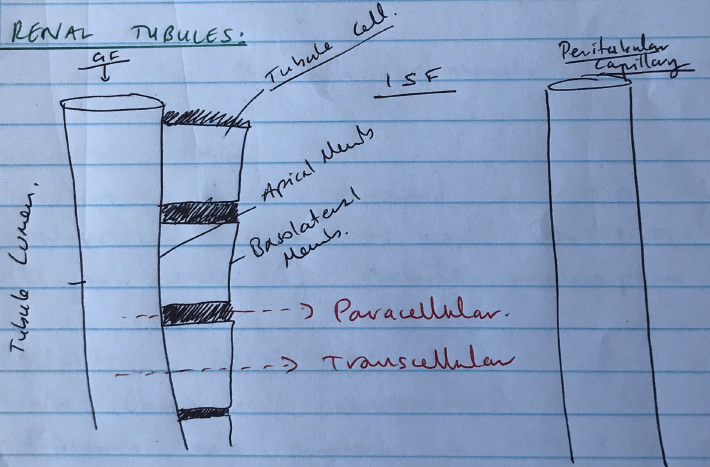15A04: Exam Report
Describe the mechanisms by which water and electrolytes are reabsorbed across the renal tubules.
33% of candidates passed this question.
The intent of the question was to have the candidate describe in the context of a classification the mechanisms by which water and electrolytes may cross a cell membrane and use the renal tubule to provide an example of each mechanism.
It was expected the answer would talk about transport “mechanisms” across membranes. These would include processes such as reabsorption, diffusion, facilitated diffusion, primary and secondary active transport, endocytosis, osmosis and solvent drag. Many candidates used colloquial and vague language to describe precise concepts.
Some candidates structured their answer as an outline of the principal mechanisms at each segment of the tubule. Thus there was repetitive reference to mechanisms without a description as requested in the question. This approach also resulted in some candidates omitting some mechanisms altogether.
H1iii / 15A04: Describe the mechanisms by which water & electrolytes are reabsorbed across the renal tubules
- Urine formation requires:
- Ultrafiltration
- Reabsorption
- Secretion
- Of 180L GFR each day → <1% filtered H2O & electrolytes is lots!
- ∴ renal tubules modulate volume & composition of urine
Diffusion
- Requires no energy
- Movement of a solute down an electrochemical gradient
- Via transcellular/paracellular route
- Gases can easily diffuse through lipid bilayer
Osmosis
- Movement of H2O from an area of high [H2O] to an area of low [H2O] across a semi-permeable membrane
- Can be through channels (aquaporins)
Solvent Drag
- When solutes dissolved in H2O follow reabsorbed water → KA SOLVENT DRAG
- Major route of solute reabsorption in PCT
Facilitated Diffusion
- Via channels/transporters
- Channels are proteins in PM with a pore → allows mass movement of a substance to happen quickly/in bulk
- No E required → moves down its [ ] & electrochemical gradient
- Transporters → are like channels, but don’t move substances as fast
- Because solute has to bind to the transporter protein & be moved, it’s not a flux movement through a channel/conduit
Types of Transporters
Uniporters
- Movement of a single molecule by a transport protein
- Driven by a [ ] gradient
- Saturable
- e. glucose, urea
Symporter
- Movement of 2° molecules in the same direction
- e. Na/K/2Cl symporter in Thick Asc. LoH
Antiporter
- 2+ solutes move in opposite direction
- e. Na/H antiporter of PCT (reabsorbs Na, secretes H+)
→ Molecular transport requires energy
→ Uniporter = down electrochemical gradient
→ Movement opposite to electrochemical gradient is ACTIVE TRANSPORT
→ Symporters & antiporters DO NOT USE ATP
∴ their active transport of solutes against electrochemical gradient is SECONDARY ACTIVE TRANSPORT → they derive E from the transport of solute not from ATP
Active Transport
- Membrane proteins which hydrolyse ATP to move solutes against their electrochemical gradient → KA ACTIVE TRANSPORT
- Most famous in tubules is the
Na/K/ATPase pump on the basolateral membrane
- Also H/ATPase of collecting ducts which causes H+ secretion
Endocytosis
- Substance is enveloped by plasma membrane
- Forms vesicle in cytoplasm
- Requires ATP = active transport e. immunoglobulins are endocytosed for processing
